Introduction
Welcome to the forefront of educational transformation! In an era where technology and learning intersect more than ever, a new player is making significant waves in K–12 education: Generative Pre-trained Transformers, commonly known as GPTs. These sophisticated AI tools are not just futuristic concepts but practical solutions already enhancing educational experiences globally.
A striking revelation from Intelligent.com highlights this shift: a remarkable 90% of students who engage in learning with ChatGPT report a more effective experience compared to traditional tutoring methods. This statistic isn’t just a number; it’s a testament to the profound impact that AI, particularly GPTs, is having on the educational landscape.
In this comprehensive guide, we delve deep into the world of GPTs, exploring their role and significance in modern K-12 education. Whether you’re an educator looking to innovate your teaching methods or an administrator aiming to stay abreast of technological advancements, understanding how GPTs can be integrated into classrooms is pivotal. We’ll walk you through what GPTs are, their potential benefits in education, and a step-by-step approach to seamlessly incorporate them into your teaching arsenal.
Get ready to embark on a journey that promises to redefine traditional teaching and learning paradigms, paving the way for a more interactive, engaging, and personalized educational experience for students.
The Emerging Role of GPTs in Education: A Future-Oriented Perspective
Let’s embark on a journey into the future of education, where Generative Pre-trained Transformers (GPTs) have just begun to leave their mark. Picture this: It’s the first day these AI powerhouses are introduced into the classroom, and the educational landscape is poised for a transformative shift.
Until now, educators using ChatGPT faced a time-intensive challenge. They meticulously crafted custom instructions, repeatedly tweaking prompts to align with their educational goals. It was a process of trial and error, demanding patience and creativity. But with the advent of GPTs, this scenario is set to change dramatically.
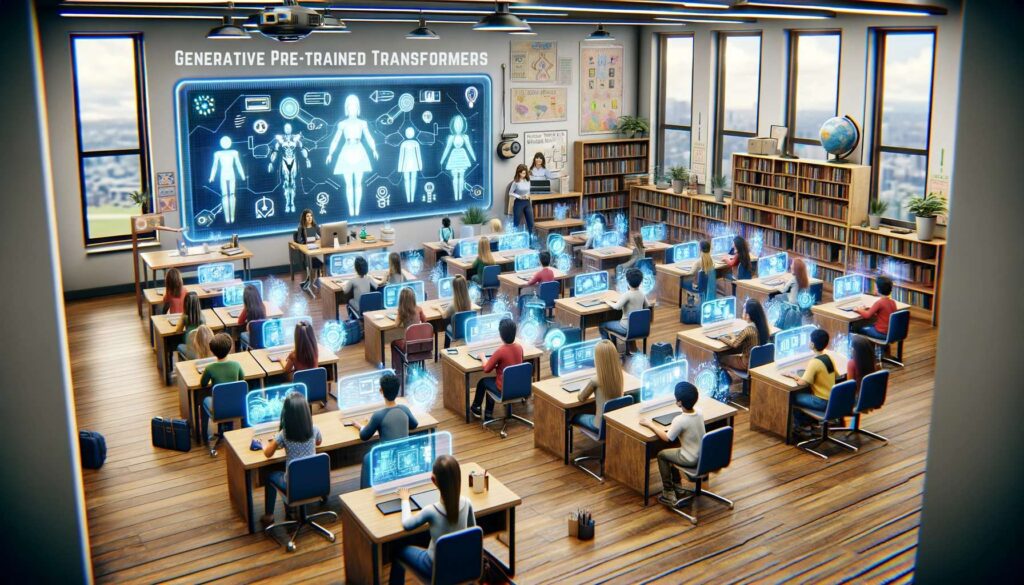
Imagine GPTs as a canvas and educators as artists. With GPTs, teachers can now paint a unique educational landscape for each subject, class, and even individual student. This technology isn’t just a tool; it’s a moldable companion. Teachers can shape their own version of ChatGPT, tailoring it to fit the diverse needs and learning styles of their students. It’s like creating a custom-made educational assistant for every classroom scenario.
This shift means a move from general to specific, from standardized to personalized. GPTs in education open a world where each student can have a learning experience designed just for them. Complex topics can be broken down to match the learner’s pace, and feedback can be as unique as the student receiving it.
But this is just the beginning. As GPTs make their debut in classrooms, we’re not just witnessing a tool being adopted; we’re seeing the birth of a new educational paradigm. One where every student has a learning path carved out just for them, and every teacher has the means to light the way. The potential is limitless, and the possibilities are endless. The future of education with GPTs is not just bright; it’s revolutionary.
Understanding the Basics Before Implementation
Before diving headfirst into the world of GPTs in education, it’s crucial to grasp the basics. This understanding lays the groundwork for successful implementation. Let’s unwrap the core concepts of GPTs and their implications in a classroom setting.
1. The Essence of GPT Technology:
- At its core, a GPT is an AI that mimics human-like responses.
- It learns from vast data, understanding language nuances.
- The goal? To interact and respond like a human, but with the speed and accuracy of a machine.
2. Customization is Key:
- With GPTs, the power lies in customization.
- Teachers can tailor GPTs to fit specific educational needs, whether it’s for a history class or a math tutorial.
- This customization extends to different learning styles and abilities, ensuring inclusivity.
3. Ethical and Privacy Concerns:
- Introducing AI into classrooms isn’t just a technological leap; it comes with ethical considerations.
- Privacy of data, especially for minors, is paramount.
- Educators must navigate these waters carefully, ensuring ethical use while protecting student information.
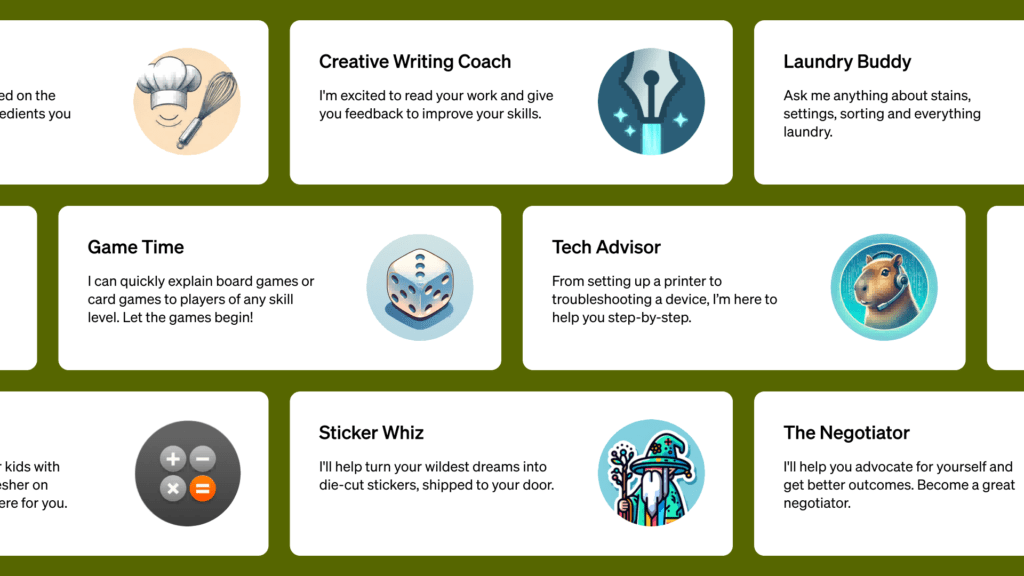
4. Preparing for Integration:
- Integrating GPTs isn’t an overnight task. It requires planning and strategy.
- Teachers need to be trained, not just in using the technology but in integrating it effectively into their teaching methods.
- It’s about augmenting, not replacing, traditional teaching methods.
5. The Role of Continuous Learning:
- GPTs are ever-evolving. Staying updated with the latest advancements is crucial.
- It’s a journey of continuous learning for both educators and students.
- Embracing this technology means being adaptable and open to change.
In summary, understanding GPTs before bringing them into the classroom is like learning the rules of the road before driving a car. It’s about harnessing their potential responsibly and creatively to pave the way for a future where technology and education merge seamlessly, offering personalized, inclusive, and dynamic learning experiences.
Step 1: Establishing Your Goals and Objectives
Embarking on the journey of integrating GPTs into education begins with setting clear goals and objectives. This foundational step ensures that the deployment of this advanced technology aligns with educational values and enhances the learning experience. Here’s how to set the stage:
1. Define Educational Outcomes:
- Begin by asking, “What do we want to achieve with GPTs in our classrooms?”
- Objectives can range from enhancing engagement to personalizing learning or improving academic performance.
- These outcomes should be specific, measurable, achievable, relevant, and time-bound (SMART).

2. Tailoring to Diverse Needs:
- GPTs offer the flexibility to cater to different learning styles and abilities.
- Set goals that address the needs of all students, including those with special educational requirements.
- Consider how GPTs can be used to support different subjects and age groups, ensuring that the technology is age-appropriate and subject-relevant.
3. Curriculum Alignment:
- It’s essential that GPTs complement and align with existing curriculum standards.
- Goals should include how GPTs can be used to reinforce key learning outcomes defined in the curriculum.
- Integration should not disrupt the curriculum flow but rather enhance and enrich it.
4. Preparing for Scalability and Flexibility:
- Plan for the potential scalability of GPT usage. Start small and scale up as comfort with the technology grows.
- Be flexible in adjusting goals as you gauge the effectiveness and reception of GPTs in the classroom.
5. Fostering Collaboration and Creativity:
- Set objectives that promote collaborative learning environments facilitated by GPTs.
- Encourage goals that stimulate creativity, critical thinking, and problem-solving skills among students.
By establishing clear goals and objectives, educators can create a roadmap for successfully integrating GPTs into their teaching methodologies. This step is about laying a solid foundation that guides the seamless incorporation of AI technology into educational settings, ensuring that it aligns with the overall vision of enhancing student learning and experience.
Step 2: Building Your Own GPT for the Classroom
Building a GPT (Generative Pre-trained Transformer) tailored for educational purposes offers an exciting opportunity for educators to create a unique AI tool for their classrooms. This step-by-step guide outlines the procedure while keeping in mind that each step may have a corresponding photo for visual support.
1. Accessing the GPT Platform:
- Start by logging into a GPT platform that allows customization.
- Ensure you have the necessary access or subscription, as some platforms may require a paid version or specific account type.
2. Setting Up Your GPT:
- Navigate to the GPT creation section on the platform.
- You’ll typically find options to create or customize a new GPT under tabs like ‘Explore’ or ‘My GPTs’.
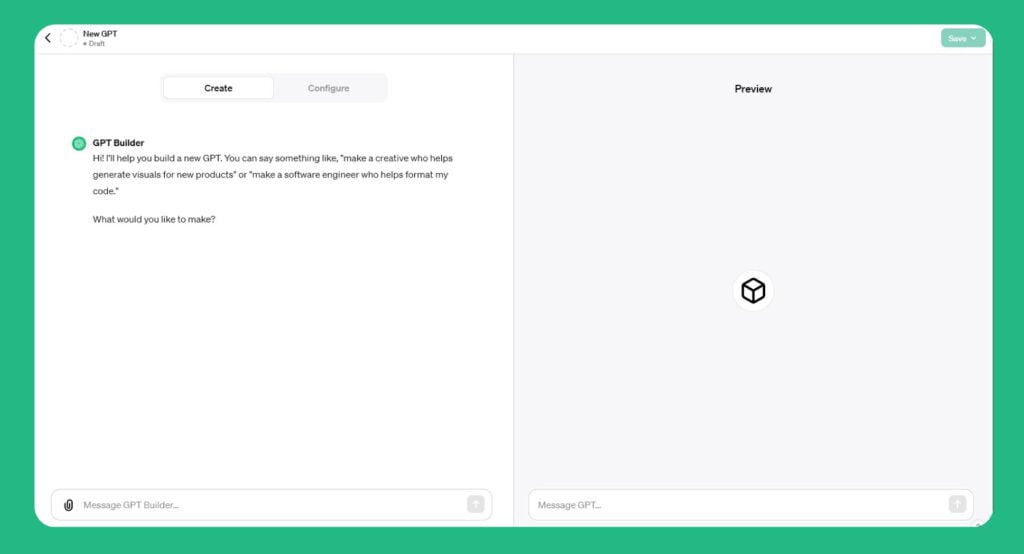
3. Defining the Purpose:
- Clearly define the purpose of your GPT. Is it for helping with math problems, assisting in language learning, or providing science explanations?
- Tailor your GPT’s focus to specific subjects, classroom needs, or even individual student requirements.
4. Customizing Instructions:
- Input custom instructions that align with your educational goals.
- Be specific about the kind of responses you expect from the GPT – for example, simple explanations for complex concepts or interactive question-answer sessions.
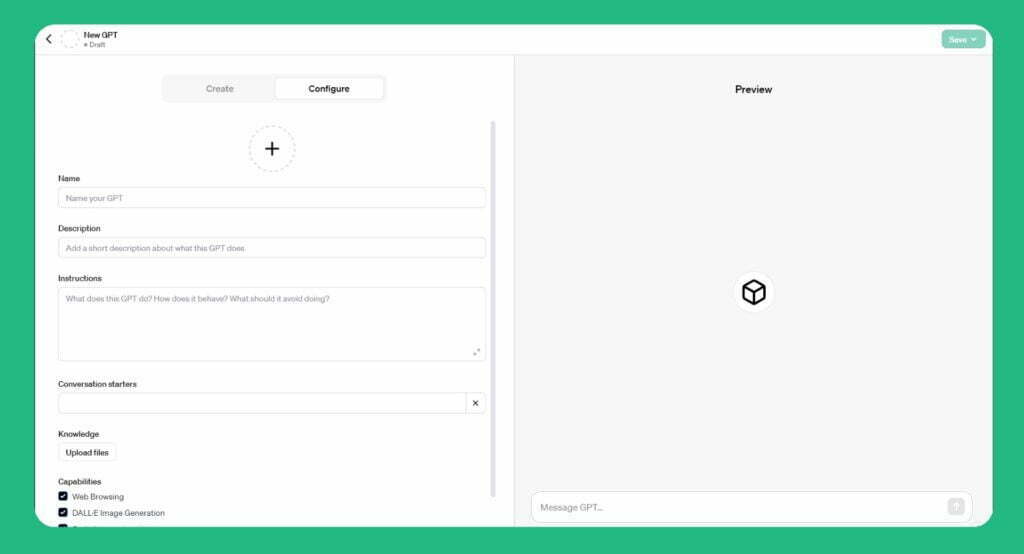
5. Uploading Educational Content:
- Upload relevant educational materials or data that the GPT can learn from.
- This could include textbooks, study guides, or any curriculum-related content.
6. Configuring Settings:
- Adjust settings like language, tone, and response style to suit your classroom environment.
- ChatGPT will guide you through this process. By prompting you with questions.
- Settings may also include content filters and privacy controls, crucial for K-12 settings.
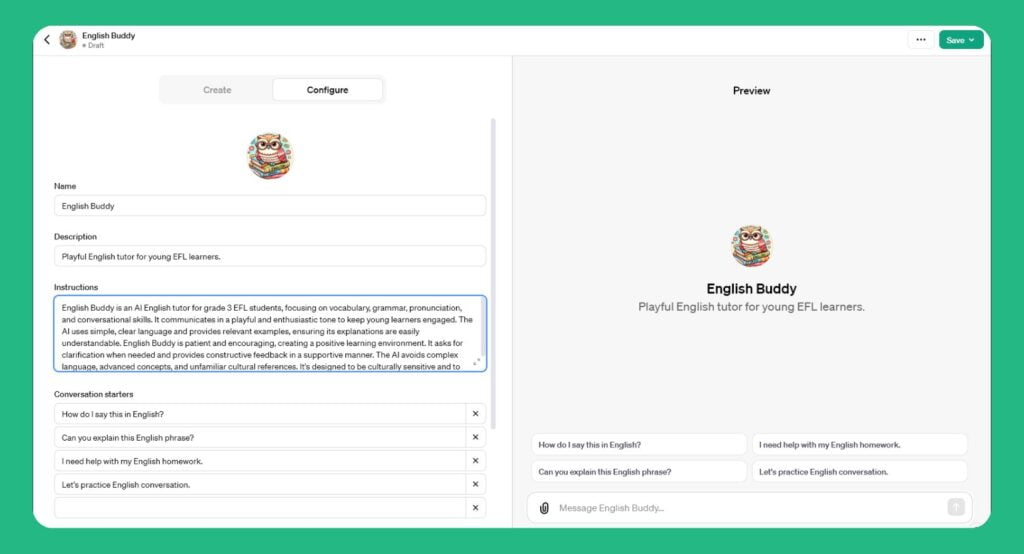
7. Testing and Tweaking:
- Interact with your GPT to test its responses and effectiveness.
- Make adjustments based on the initial interactions – you might need to refine instructions or upload additional content for better accuracy.
8. Integrating With Classroom Tools:
- If possible, integrate your GPT with existing classroom tools or platforms for seamless use.
- This step ensures the GPT can be easily accessed and used during lessons.
9. Finalizing and Launching:
- Once satisfied with the setup and performance, finalize your GPT.
- Prepare for its introduction into the classroom, possibly starting with a pilot phase or specific lessons.
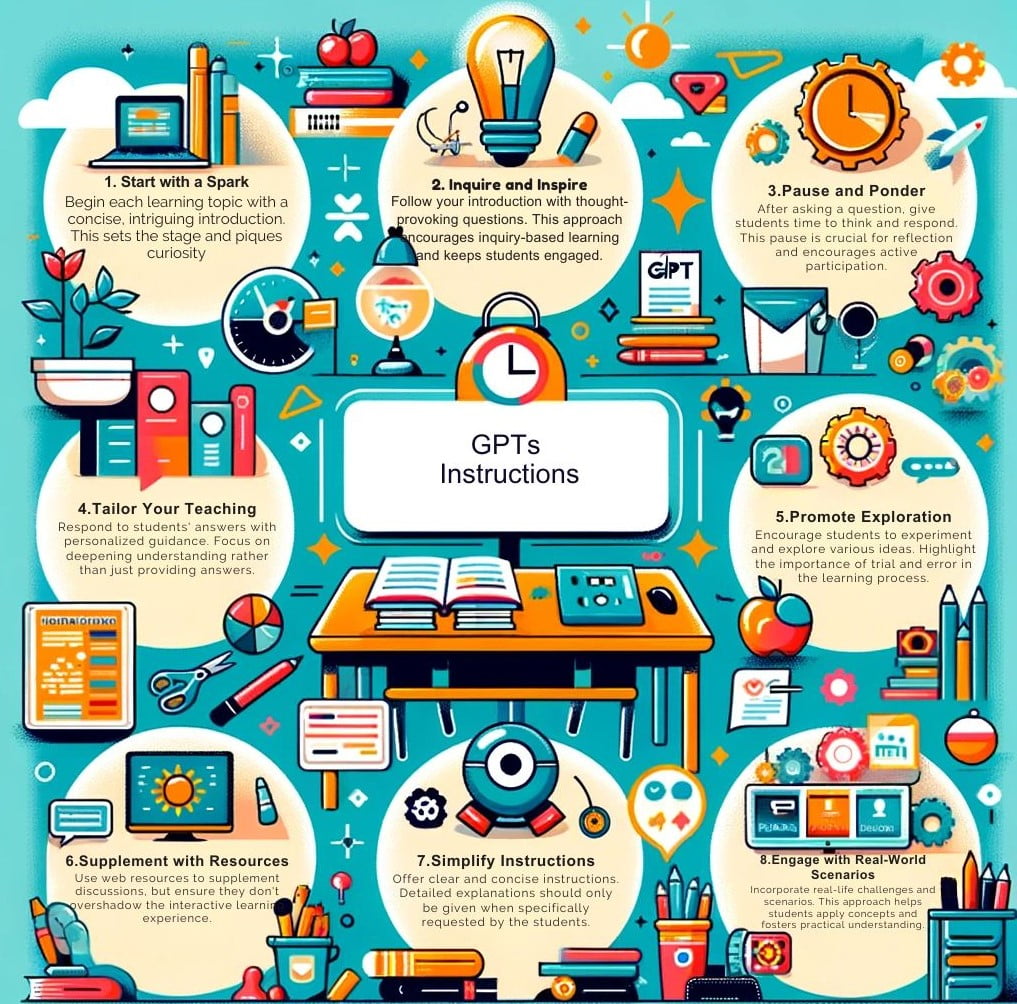
10. Continuous Improvement:
- Regularly update the GPTs in education based on classroom experiences and feedback.
- Stay updated with platform enhancements to continuously improve your GPT’s functionality.
By following these steps, educators can build a GPT that not only complements their teaching style but also enriches the learning experience for students, making education more interactive, personalized, and engaging.
Step 3: Integrating GPTs into Lesson Plans
Successfully integrating Generative Pre-trained Transformers (GPTs) into existing lesson plans is a game-changer in education. It’s about bringing AI into the classroom in a way that enhances learning without disrupting the established curriculum. Here’s how to do it effectively:
1. Identify Integration Points:
- Review your current lesson plans to identify areas where GPTs can add value.
- Look for topics or activities where personalized AI assistance could enhance understanding or engagement.
- Ideal integration points could be complex topics, creative assignments, or areas where students typically require additional support.
2. Create GPT-Aided Activities:
- Design specific activities where GPTs play a central role. For example:
- A creative writing task where GPTs help students generate ideas or provide grammar assistance.
- Math problem-solving sessions where GPTs offer step-by-step guidance.
- Language learning exercises with GPTs facilitating conversation practice.
- Ensure these activities align with learning objectives and are suitable for the students’ age and skill levels.
3. Blend with Traditional Methods:
- Balance is key. GPTs should complement, not replace, traditional teaching methods.
- Use GPTs as a tool to reinforce concepts taught through conventional means, offering a blended learning experience.
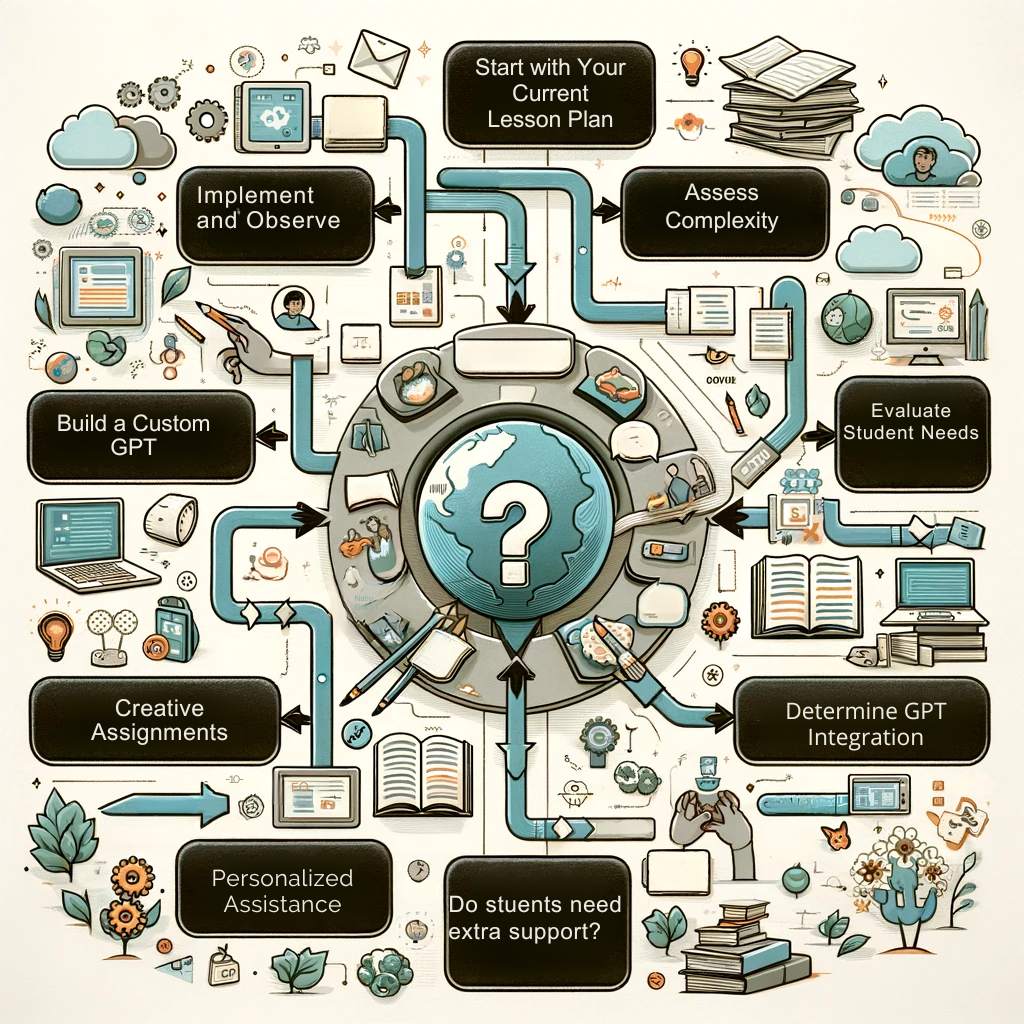
4. Prepare for the Learning Curve:
- Recognize that integrating GPTs into the classroom is a learning process for both students and teachers.
- Provide training sessions or introductory workshops for teachers to become comfortable using GPTs.
- Introduce students to GPTs gradually, starting with simple tasks before moving to more complex interactions.
5. Foster Collaborative Learning:
- Encourage students to work in groups on GPT-aided projects. This promotes collaboration and shared learning experiences.
- Facilitate discussions on how GPTs can be used, encouraging students to brainstorm and share ideas.
6. Monitor and Adjust:
- Continuously monitor how GPTs are impacting the learning process.
- Seek feedback from students and teachers, and be ready to adjust the integration strategy as needed.
7. Document Best Practices:
- Keep a record of successful strategies and activities where GPTs have been particularly effective.
- Share these insights with colleagues to help them integrate GPTs into their lesson plans.
By strategically integrating GPTs into lesson plans, educators can offer a dynamic, interactive, and personalized learning experience. It’s about harnessing the power of AI to make education more engaging, inclusive, and effective for every student.
Step 4: Training and Support for GPT Integration
As educators embark on the journey of integrating GPTs into their teaching, adequate training and support are crucial. This step ensures that both teachers and students can effectively utilize this innovative technology. Here’s a guide to setting up a robust training and support system:
1. Educator Training Workshops:
- Organize workshops or professional development sessions for educators focusing on the basics of GPTs.
- Cover essential topics like operating the GPT platform, customizing GPTs for different subjects, and integrating AI into lesson plans.
- Since GPTs are relatively new in the educational sphere, these sessions should be hands-on and interactive, encouraging educators to experiment and explore.
2. Leveraging Online Resources:
- Utilize available online resources to supplement training. For instance, the video “An Introduction to GPTs and Their Applications in Education” offers a comprehensive overview that can be beneficial for educators starting out with GPTs.
- Encourage educators to seek out additional online materials, forums, or communities for continued learning.
3. Student Orientation:
- Introduce students to GPTs in education technology through in-class demonstrations or introductory sessions.
- Explain how GPTs will be used in their learning, addressing any questions or concerns they might have.
- Ensure students understand the purpose of GPTs in their education and how to interact with them effectively.
4. Setting Up a Support System:
- Establish a support system where educators and students can get assistance with GPT-related queries.
- This could be a dedicated IT support team in the school or a designated teacher who has advanced knowledge of GPTs.
- Create a FAQ resource or a help guide that can be easily accessed for common questions or issues.
5. Regular Feedback and Updates:
- Implement a system for regular feedback from both teachers and students on the use of GPTs.
- Use this feedback to make necessary adjustments to the training and support offered.
- Stay updated with the latest advancements in GPT technology and update the training materials accordingly.
6. Building a Community of Practice:
- Encourage the formation of a community of practice among educators where they can share experiences, best practices, and challenges related to GPT integration.
- Such a community fosters collaborative learning and collective problem-solving.
By providing comprehensive training and robust support, schools can ensure that the integration of GPTs into education is smooth, effective, and beneficial for both educators and students. It’s about building confidence and competence in using this cutting-edge technology to enhance the educational experience.
Step 5: Monitoring and Evaluating the Impact of GPTs in Education
Once GPTs are integrated into the classroom, it’s crucial to monitor and evaluate their impact on learning outcomes. This step involves using various tools and methods to assess effectiveness, gathering feedback, and making necessary adjustments. Here’s how to approach this vital phase:
1. Utilizing Assessment Tools:
- Implement digital assessment tools that can track student performance and engagement with GPT-aided activities.
- Look for changes in test scores, assignment quality, and participation rates as indicators of the GPTs’ impact.
- Use analytics features within the GPT platform (if available) to gain insights into usage patterns and learning improvements.
2. Feedback Collection:
- Regularly collect feedback from students and educators through surveys, interviews, or informal discussions.
- Ask students about their experiences with GPTs, focusing on aspects like ease of use, understanding of concepts, and overall engagement.
- Encourage educators to share their observations on student progress and any changes in classroom dynamics due to GPT integration.
3. Observational Studies:
- Conduct classroom observations to see firsthand how GPTs are being used and their effect on teaching and learning processes.
- Look for non-quantifiable changes like increased student motivation, curiosity, and collaborative interactions.
4. Comparative Analysis:
- Compare the performance and engagement levels of classes using GPTs with those that do not.
- This comparison can provide a clearer picture of the added value brought by GPTs.
5. Adjusting Strategies Based on Data:
- Analyze the collected data and feedback to identify areas where GPTs are most and least effective.
- Based on these insights, adjust your GPT integration strategies. This might include changing how GPTs are used in lessons, addressing technical challenges, or providing additional training.
6. Reporting and Documentation:
- Document the findings and changes made as a result of the evaluations.
- Share these reports with stakeholders, such as school administrators or educational technology teams, to inform future decisions regarding GPT usage.
7. Continuous Improvement:
- Treat the integration of GPTs as an ongoing process. Continuously look for ways to improve their use in the classroom based on the latest research, technology updates, and feedback from the school community.
By thoroughly monitoring and evaluating the impact of GPTs, educators can ensure that this innovative technology is being used to its fullest potential, enhancing the educational experience and outcomes for students.
Conclusion: Embracing the Future of Education with GPTs
As we reach the end of our guide on building and integrating GPTs in K–12 classrooms, let’s take a moment to reflect on the journey we’ve embarked upon. We’ve explored the foundational steps of understanding GPTs, setting clear goals, custom-building these AI tools for specific educational needs, strategically integrating them into lesson plans, and assessing their impact on learning outcomes.
The integration of GPTs in education marks a significant stride towards a future where learning is not just about absorbing information but about engaging with it in a dynamic and personalized way. The potential of GPTs to revolutionize the classroom experience is immense, from offering individualized learning paths to fostering a deeper understanding of complex subjects. It’s an opportunity to redefine the boundaries of traditional education and to prepare our students for a future where AI is an integral part of life.
Call-to-Action: Join the Conversation on GPTs in Education
As we navigate this exciting new landscape, your experiences, insights, and questions are invaluable. We invite you to share your journey with GPTs in the classroom. How have they impacted your teaching methods? What challenges and successes have you encountered?
If you’re looking for more information or wish to connect with other educators exploring AI in education, check us out on Twitter.
Together, let’s shape a future where technology and education converge to create enriching, inclusive, and inspiring learning experiences for all students.
FAQ on GPTs in Education
What are GPTs in Education, and how do they benefit students?
GPTs in Education refer to AI tools used to enhance learning experiences. They offer personalized assistance, make complex concepts more accessible, and cater to various learning styles, significantly benefiting students.
Can GPTs in Education be customized for different subjects?
Yes, GPTs can be tailored to suit a wide range of subjects in K-12 education. They can be programmed to address specific topics, making them versatile tools for teaching various subjects.
Are there privacy concerns when using GPTs in Education?
Privacy is a key concern with GPTs in Education. Schools must ensure that these AI tools comply with privacy laws and safeguard student data, especially in K-12 settings where minors are involved.
How can teachers integrate GPTs into existing lesson plans?
Teachers can integrate GPTs into lesson plans by identifying areas where AI assistance can enhance learning, like providing additional support for challenging topics or enriching creative projects.
What kind of training do educators need to effectively use GPTs in Education?
Educators require training in operating GPT platforms, understanding their features, and integrating these tools into their teaching methods. Continuous learning is also crucial as GPT technology evolves.
How is the effectiveness of GPTs in Education evaluated?
The effectiveness of GPTs in Education is evaluated through various methods, such as tracking student performance, collecting feedback from educators and students, and observing changes in engagement and comprehension.







Recent Comments